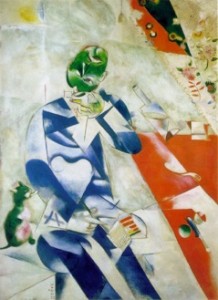CHAGALL, MARC
Chagall believed that art’s primary function was to interpret the world through iconography and allegory. He had total faith in the power of the image, and from around 1911 began to introduce metaphor into his work.
Unlike other artists at this time in Paris, Chagall didn’t question the theoretical and material limits of painting – he simply got on with it, crafting his paintings with immaculate technique and energetic brushwork.
Chagall chose to remain relatively isolated from his fellow artists, preferring the company of writers and poets. He became particularly close to Guillaume Apollinaire and Blaise Cendrars; the latter chose the titles for several of his key paintings including Half-Past Three (The Poet) 1911. This large painting has distinctly cubist tendencies, undercut by a non-naturalistic colour scheme and layers of literary references. It demonstrates the productivity of Chagall’s encounter with cubism.
His self-identification in The Poet Reclining,1915 as a poet rather than an artist is telling, reinforcing his preference for the literary rather than artistic world, as suggested by his friendships in Paris

